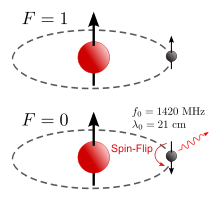Excited state
An excited state of a physical system is any state whose energy is greater than the lowest possible, i.e. H. greater than the energy of the ground state . The term is mainly used for systems that can only assume states with certain discrete energies , as described by quantum mechanics .
Stability and lifespan
Experience has shown that a physical system left to its own devices usually strives to achieve the lowest possible energy content by releasing energy. This can be explained by the probabilities of the different system states in the phase space : Once an energy released in any form (through friction , nuclear fission , generation and emission of new particles such as photons , β-radiation, etc.) generally only returns to the original system with a negligible probability back. An excited state is therefore generally not stable, but has a finite mean life , in other words, a decay probability per unit of time for the transition to a less highly excited state or the ground state. The mean lifetimes can range from fractions of a second to millennia. Measured values cover a range of 55 powers of ten, probably the largest that occurs in any physical measurand.
Excited states with particularly long lifetimes are sometimes referred to as metastable ; see e.g. B. Isomer (nuclear physics) .
Atomic physics
The ground state of an atom is determined by the energetically lowest electron configuration . By supplying energy, e.g. B. by absorbing a photon with a suitable energy ( light ) or by an inelastic collision ( shock excitation , see e.g. Franck-Hertz experiment ), an electron can be raised to a higher energy level ( doctorate , excitation ). The disintegration into an energetically lower state ( de-excitation ) occurs either spontaneously or is triggered by an external disturbance. The released energy is released into the environment in some form, e.g. B .:
- as a photon ( spontaneous or stimulated emission )
- or radiationless, for example through the emission of another, less firmly bound electron ( Auger electron ).
If the basic state does not return in the otherwise usual, very short time of less than a microsecond, one speaks of a metastable state , which can be explained by conflicting selection rules . The decay of a metastable state is also known as a forbidden transition .

In the hydrogen atom, the spins of the electron and proton can be parallel or antiparallel. The antiparallel state has slightly higher energy, which is emitted as a photon when it is folded back. This radiation is an important detection method in astronomy for highly diluted hydrogen gas.
Examples
Impact excitation explains , among other things, the color of the flame due to alkali and alkaline earth metals . There the energy supply is generated by collisions between the atoms (and molecules) in the hot flame - i.e. by heat.
Shock excitation also plays a role in light generated in gas discharge tubes (e.g. neon tubes ). The flowing electrical current causes collisions between free electrons and the atoms, which lead to excitation or ionization . In the case of aurora borealis , protons of cosmic rays and free electrons released by them cause the collisions. Recombination takes place after ionization . This usually takes place via excited states. When they decay, the energy released is emitted as light.
Ionizing radiation can knock atoms out of their lattice positions . If these do not return to their original position, crystal defects occur that may persist for a long time. This represents a form of energy storage. Thermoluminescence allows these metastable excited states to be converted back into light. If neutrons cause these lattice defects in graphite, one speaks of Wigner energy .
In order to characterize the occupation of excited states in many-particle systems , a description by quasiparticles is often used . For example, the excitation of lattice vibrations in a crystal can be described as the generation of phonons .
See also
literature
- Jörn Bleck-Neuhaus: Elementary Particles. Modern physics from the atoms to the standard model (Chapter 6) . Springer, Heidelberg 2010, ISBN 978-3-540-85299-5 .
Individual evidence
- ↑ Bergmann-Schaefer: Textbook of Experimental Physics , Volume 4: Particles, de Gruyter, Berlin, 1992, ISBN 3-11-010977-8 , p. 241.
